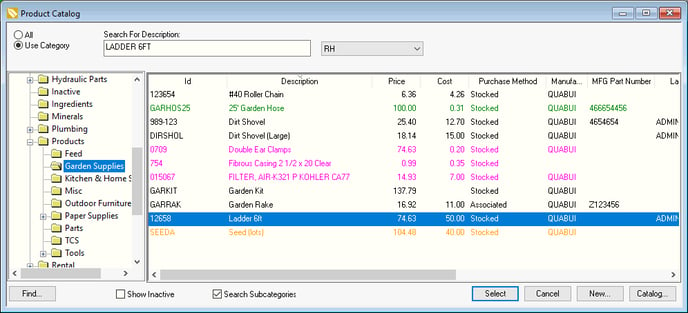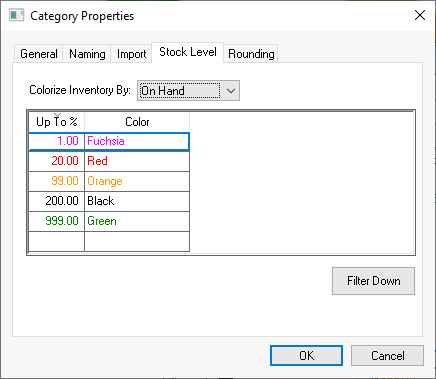- EBMS Knowledge Base
- Inventory
- Purchasing
-
Client Resources
-
EBMS Main Documentation
- Introduction
- Getting Started
- Getting Started | Initial Installation
- Getting Started | Company Setup
- Quick User Guide | Financial Staff | Accountant
- Quick User Guide | Financial Staff | Accountant | Accountants Journal
- Quick User Guide | Sales Staff
- Quick User Guide | General Staff
- Features
- Reports
- Security
- Server Manager
- Technical
- Technical | Data Import and Export Utility
- Technical | SQL Mirror
- Automotive
- Automotive | Parts Catalog
- Automotive | Pricing
- Automotive | Point of Sale
- Automotive | Product Application
- Automotive | Keystone Interface
- Metal Supply
- Fuel Sales
- Horticulture
- Horticulture | Farm Setup
- Horticulture | Processing Payroll
- Horticulture | Managing the Farm
-
Sales
- Introduction
- Customers
- Customers | Miscellaneous Customers
- Proposals
- Proposals | Processing Proposals
- Proposals | Sets and Templates
- MyProposals
- MyOrders
- Sales Orders
- Invoices
- Materials Lists
- Sales and Use Tax
- Sales and Use Tax | TaxJar
- CRM
- CRM | Auto Send
- Recurring Billing
- Credits
- Customer Payments
- Payment Card Processing
- Payment Card Processing | Gift Cards
- Payment Card Processing | Loyalty Cards
- Payment Card Processing | Verifone Gateway
- Freight and Shipping Tools
- General Ledger Transactions
- Point of Sale
- Point of Sale | Point of Sale Hardware
- Point of Sale | Xpress POS System
- Point of Sale | Advanced Tools
- Signature Capture
- Salesperson Commissions
-
Inventory
- Product Catalog
- Product Catalog | Using Product Codes for No Count Items
- Product Pricing
- Product Pricing | Special Pricing
- Tracking Counts
- Unit of Measure
- Purchasing
- Special Orders and Drop Shipped Items
- Receiving Product
- Barcodes
- MyInventory and Scanner
- Components (BOM) and Accessories
- Components (BOM) and Accessories | Component Formula Tool
- Made-to-Order Kitting
- Configure-to-Order Kitting
- Multiple Inventory Locations
- Multiple Inventory Locations | Creating Locations
- Multiple Inventory Locations | Using Multiple Locations
- Multiple Inventory Locations | Product Catalog Sync
- Multi-Vendor Catalog
- Serialized Items
- Serialized Items | Purchasing or Manufacturing an Item
- Serialized Items | Selling and/or Associating an item with a customer
- Lots
- Product Attributes
- Product Attributes | Selling and Purchasing Items with Attributes
- Product Attributes | Custom Attributes
- Mobile Scanner (Legacy)
-
Labor
- Getting Started
- Workers
- Taxes and Deductions
- Work Codes
- Time and Attendance
- Time and Attendance | Time Track App
- Processing Payroll
- Closing the Payroll Year
- Processing Payroll - Advanced
- Salaried Pay
- Piecework Pay
- Direct Deposit
- 3rd Party Payroll Service
- Subcontract Workers
- Flag Pay
- Prevailing Wages
- MyDispatch
- MyTasks
- MyTime
- MyTime | Communications
- MyTime | Setup
- Tasks
- Tasks | Getting Started
- Tasks | Creating Tasks
- Tasks | Scheduling Tasks
- Tasks | Customizing Task Views
- Tasks | Managing Tasks
-
Financials
- Introduction
- Fiscal Year
- Chart of Accounts
- Budget
- Financial Reporting
- Transactions and Journals
- Transactions and Journals | Journals
- Account Reconciliation
- 1099
- Departments and Profit Centers
- Fund Accounts
- Bank Accounts
- Bank Feed
- Vendors
- Vendors | Miscellaneous Vendors
- Purchase Orders
- Expense Invoices
- Vendor Payments
- AP Transactions
- Landed Cost
- Fixed Assets and Depreciation
- Fixed Assets and Depreciation | Fixed Assets
- Fixed Assets and Depreciation | Fixed Assets | Adding Assets
- Fixed Assets and Depreciation | Processing Depreciation
- Fixed Assets and Depreciation | Disposing Assets
- MyJobs
-
E-commerce
-
Rental
-
Job Costing
-
Manufacturing
Stock Level Color
The stock level values within the product catalog of EBMS can create a sea of numbers. The purpose of the optional Stock Level coloring is to use color codes to visually indicate when stock levels are low or high. These color codes indicate when stock levels are high (green or blue), comfortable (black), or low (orange, red, or fuchsia).

This same color coding can be shown on the purchasing dialog.
This color coding can be applied to a specific group of folders or can be applied to the entire product catalog. The color code can vary between product categories or folders.
Stock Level Color ERP Support Training
NOTE: EBMS must be closed and restarted before any new Stock Level colors take effect.
Configure Stock Level Settings
Complete the following steps to configure the Stock Level color within the product catalog:
- Right click on the root folder that contains the items to color code. Select the root folder to set the same color code for all folders or select a sub-folder to color code a subset of the catalog.

- Select Properties from the context menu and select the Stock Level tab as shown below:

- The color coding is based on a percentage of the inventory count metric compared to the Minimum stock level setting found in the Count tab of the item. (Percentage = user selected Inventory value / Minimum stock level). Review Tracking Counts > Item Count for information on these various inventory values. Select one of the following Colorize Inventory By: values used to calculate the Color code.
- Net Ordered
- Available
- On Hand
-
(No color)
-
Enter the Up to % value for each color code. Enter the percentage value (= Colorize Inventory by setting / Minimum stock level) for each color level.
-
Select a corresponding color.
-
Click on the Filter Down button to set the Stock Level colors for all sub-folders.
-
Repeat these steps for all additional folders or sub-folders.
-
IMPORTANT: Exit EBMS and restart to make new Stock Level colors take effect.
Colorize Color Level in Purchasing Page
The colorize color process can be enabled within the purchasing dialog by enabling the Colorize Stock Level option.
Warning: this option may reduce the performance of the F5 product loading process.

Enable the Colorize Stock Level option on the bottom of the purchasing dialog to color code product based on the stock levels. Reference the instructions to configure Stock Level colors on a per product category basis.
Related Videos and Content
Videos
